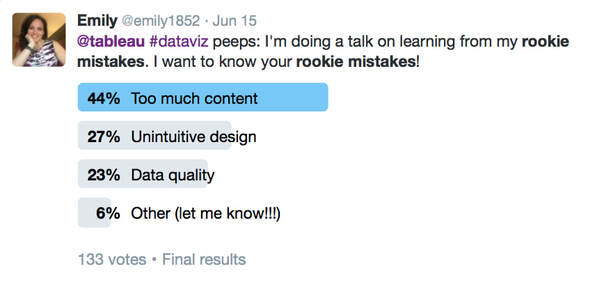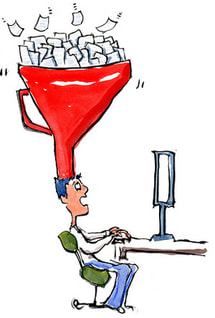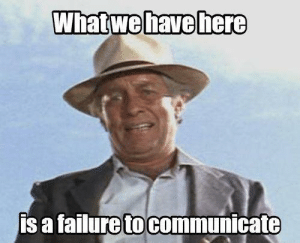|
Back in 2016, I gave a talk to the internal AARP Tableau meeting called Rookie Mistakes and Resources. I just found a paper copy! of the slides for that talk and after looking at them, I think they're still pretty relevant today. Imagine my excitement, I got my first Tableau project and it's a big deal. I developed a workbook that measures commitments. I collaborated with folks, I got help with the data (since it wasn't readily consumable), I did the work and then it was the big day...I presented to the senior management and the reception was...less than ideal. In fact, it was awful. "How do you read that?" "That number doesn't look right!" "How did you arrive at that?" "There's too much in here." I can recall that meeting like it was yesterday and the talk I got afterwards and how it felt like my career was over. I presented to these senior managers and got crushed. These were not warm and fuzzy people. And I felt alone. No one had my back. My reputation (in a very flat organization) took a major hit. That was my worst Tableau experience ever. After going through something like that, I was (and am) determined for people to have that same experience. Here are my top rookie mistakes and how people can overcome them. too much contentMy mistake One of my biggest mistakes was trying to incorporate everything that management wanted on a dashboard. I didn't push back and tried to please everyone who had a suggestion and as a result, I had too much content and my messaging wasn't clear. Because it was too much, no one could quickly get the message. How to overcome Get focused. Ask your audience questions like: "What are the most important items?" "What can be supplemental?" I used the supplemental tactic to create a separator dashboard that just read, "Supplemental Information" and then provided the detail in other worksheets or dashboards that followed. In the talk, I described that I had different workbooks depending on the audience. For senior managers, they just need the high-level view, whereas with the operational folks, I used another workbook that was more detailed and exploratory. data quality/accuracyMy mistake I knew the general concepts but relied on the person that transformed the data in the operational data store for the details. The interesting part is that I contributed to the data, so I understood it at the point of data entry but when it was put in a view that we connected to, I didn't understand what happened. So when I got questions about the data, I couldn't really answer them, which made me look inept. How to overcome Dig in and get detailed. Make the data people (if that's not you) explain what happened because it's not a good look for you or them if you can't explain it. But it's not just for management. Management information systems (which Tableau dashboards are a part of), should be timely, accurate, relevant, and complete. By doing the details of the data you can help ensure that these four points are met. AccessorizingMy mistake A powerful tool requires all the things right? Tableau lets me visualize the data as a circle plot, so I'm gonna do it!! I'm gonna zhuzh this dashboard up. Oh... and they need filters, so they can filter for anything they might want to filter for. I think you can see where this is going. How to overcome I started thinking like Coco Chanel. I was accessorizing the data so when I thought I was done, I'd take a look at my dashboard and think, is there something that is extra that needs to be removed? Since this talk in 2016, any time I've taught students, I've used this Coco Chanel approach to dashboarding. Too complexMy mistake "I don't know how to read this chart." Complexity obscured the message. I was showing off my dataviz and Tableau skills and made it too difficult for my audience to understand what I was actually trying to convey. How to overcome There is beauty in simplicity. Know your audience (KYA)...my audience was that tried and true--read a chart in five seconds kind of audience, so a circle plot when a highlight table would have been so much better, created a bad experience (for them and me). I tried educating the audience on this chart...I tried multiple times. That's when you know that it's your chart, not them. Have the courage to change your chart. I was thinking about the situation I was in all those years ago, I think to myself...how could I have done this differently. This project was in 2011 or 2012, so I didn't really have a network to speak of. There were people who knew how to do Tableau, but they were either unable or unwilling to provide the feedback that I needed to hear. And my supervisor didn't know Tableau or data visualization, so I couldn't go to them for help. The Tableau community isn't any where as big as what it is now, but I wish I had:
And then I thought about what if my chart was actually fine and it was actually them (this wasn't the case, but I imagine someone reading this thinking, but my chart is perfect for the data, what should I do then)? How can I move them to become comfortable with this different chart type. KYA is key. Can I give them a simpler/easy to understand chart now, continue to educate, and then transition them to something more complex? Regardless of whether it's your chart or them, peer review is essential. My biggest mistakes of allLooking back, I think there were two major mistakes (maybe even bigger than the ones listed above).
It's not just meI polled people on the twitters right before my talk about their rookie mistakes. In addition to the results below, I got a lot of "Can I choose all?!"  Twitter poll from Jun 15, 2016 that asked, @tableau #dataviz peeps: I'm doing a talk on learning from my rookie mistakes. I want to your rookie mistakes. This is followed by a bar chart that indicates that 44% indicated Too much content, 27% unintuitive design, 23% data quality, or 6% other. This poll received 133 votes. I hope these rookie mistakes resonated with you so that you don't have to go through the pain I went through!
Let me know if this was helpful or what rookie mistake you would add! -Em
2 Comments
I was teaching an intermediate type of Tableau class recently and one participant seemed to be struggling. To be fair, she should have been in. an intro class, but she enrolled in this one, so there we were. Since I recently shared some of these tips with the student, I thought I would share them here, partially as a reminder for me and if you (or your students need it, then here you go).
Even though I think Tableau is a great tool, it can be overwhelming, especially when you're new. Here are a few tips I use and share with new users. 1. Breathe 2. Look to see what data elements are in the question or the statement for what you're trying to analyze/visualize. As an example: What's the trend in sales over time? In an intro class, I normally break it down this way: What's the trend in sales over time? Bolding means it's a data item. The italicized words are those that I need to look at or do something with. I'm going to need a trend line and I'm going to need to find a date based data element (and I use over time as a cue to first think of continuous vs. compare for discrete). So, if I were looking at Superstore Sales data set for Tableau, I know that I'll need sales and order date. 3. When it's something more than a basic chart, try to see if there's a base visualization that you can create or that it looks like. I recently shared with someone how to create a quadrant chart. At the base, it's a scatterplot and then you add on reference lines. That doesn't sound so daunting when you think of it that way. 4. Are you trying to reverse engineer something? Be super observant. Where are the pills? What color are they? Notice those little details to help you re-create the visualization for yourself. 5. Google it. The Tableau community is so super knowledgable. Your question may have already been thought of and addressed, so see what the community says. 6. Find your person/people. I remember when I first started (and even now, sometimes), I was so frustrated and I would message Matt Francis... why can't I get this?!? Why can't it be easier? I'm a pretty smart person but I feel so dumb. Help!! And Matt would help, without judgement. <--that's huge. 7. Remind yourself: You are smart, you've got this! We all have different zones of competence. So while someone may be amazing at calculations, they could also be afraid of the blank canvas. Give yourself grace to learn. Sometimes you come across a Tableau unicorn and that's amazing. But, it's more likely that we each have a specific thing that we love and can jam out on. And even if you're still like: But Em, I am struggling with the whole thing, I bet you have a zone of competence outside of Tableau that's super amazing (and you can't forget about that). And finally, different aspects of the tool click at different times. I think it's easy to hear stories about what's possible like the people who become a rockstar in a weekend. That's amazing and I will celebrate them. But I also know that person is an outlier. A lot of times, it takes more than two days to master the tool. So if you're not grasping a concept immediately, that's ok. Calculations for me, are one of those things that I still have trouble with. But have I told you about how much I love swapping parameters (I might have even scared the class a little bit with my super excitement over them. Though seriously, aren they so cool? Your user can pick their dimension and measure!) 😍 It's another reason why building a network is so important, whether that's at work or in the broader Tableau community. When someone needs help with calculations, they can go to someone else. When they need help with thinking like a CEO, teaching (or based on my excitement level, swapping parameters), they can come to me. I hope these tips have been helpful! Let me know your favorite tip to prevent Tableau overwhelm below! |
Emily KundHelping people and organizations begin their data visualization and Tableau journey. I'm a fan of training, Tableau, data viz, my kids, cupcakes, and karate. Archives
January 2023
Categories
All
|





 RSS Feed
RSS Feed